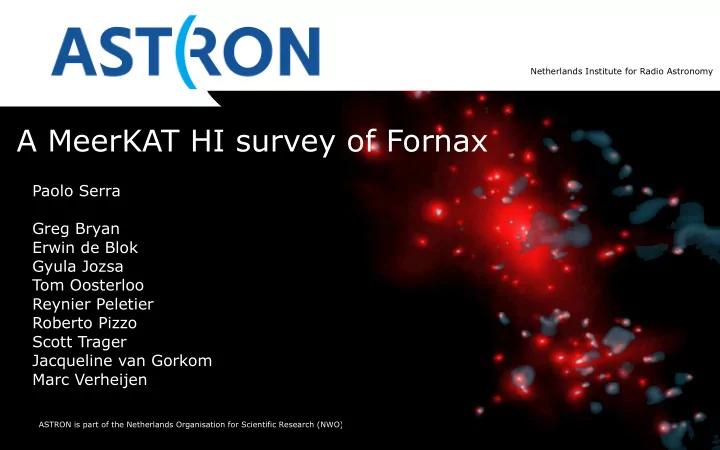

Netherlands Institute for Radio Astronomy A MeerKAT HI survey of Fornax Paolo Serra Greg Bryan Erwin de Blok Gyula Jozsa Tom Oosterloo Reynier Peletier Roberto Pizzo Scott Trager Jacqueline van Gorkom Marc Verheijen ASTRON is part of the Netherlands Organisation for Scientific Research (NWO)
Outline • Scientific background • Aim of the survey • Design of the survey Paolo Serra
Galaxy evolution and large-scale structure Galaxies form over a large range of overdensity on the cosmic web The correspondingly large range of physical conditions generates a coupling between galaxy evolution and the formation of large-scale structure (observationally, morphology-density relation) Paolo Serra
Cluster formation M=10 15 M SUN Tonnesen, Bryan & van Gorkom 2007 stars neutral hydrogen 10 Mpc Cluster assembly is an anisotropic process Massive stripping of cold gas occurs Paolo Serra
Cold gas in clusters (1) As galaxies fall in, gas is stripped by: Much of what we know comes from Virgo (M=5x10 14 M SUN ) - interaction with the hot intra-cluster medium - a variety of gas-stripping mechanisms, with unclear balance as a - tidal forces from the cluster potential function of distance from the cluster centre - interaction between galaxies - very gas-poor early-type galaxies (unlike in groups/field) ...and accretion of cold gas from the surrounding medium stops How does all this depend on environment density? Kenney et al. 2008 Chung et al. 2009 Oosterloo & van Gorkom 2005 Paolo Serra
Cold gas in clusters (2) Coma Abell 2670 Poggianti & van Gorkom, 2001 Bravo-Alfaro et al, 2001 Infalling galaxies are clustered in space and velocity Paolo Serra
HI survey of Fornax Drinkwater et al. (2001) Why Fornax - low X-ray luminosity (M = 7x10 13 M SUN ) - it’s growing now - gas-rich outskirts - nearby (d=20 Mpc) Why MeerKAT - ideally located ( δ = − 35 deg) - focus on relatively small field (11 deg 2 ) - deep observation Paolo Serra ESO 1.0 x 1.5 deg 2
Science goals • connection between galaxies falling in the cluster and the neutral cosmic web feeding cluster growth • physics of the gas-stripping process, separating between tidal and ICM-driven stripping • gas content of early-type galaxies in clusters down to unprecedented sensitivity • gas content of dwarf galaxies and transformation from late- to early type • connection to cosmological and high-resolution simulations tailored to Fornax Paolo Serra
Survey design • 49 pointings on hexagonal grid - spacing FWHM / √ 3 • 50 h / pointing (giving σ of 100 h integration) • total: 2,450 hours, 11 deg 2 at σ ≤ 1.1x σ min • n HI (3 σ )=1x10 18 cm -2 (90 arcsec, 30 km/s) 5x10 18 cm -2 (30 arcsec, 15 km/s) 4x10 19 cm -2 (10 arcsec, 10 km/s) • M HI (3 σ )~5x10 5 M SUN • ~10 times deeper than WALLABY Observable for 6 months per year for >5 h night-time: 10x5 h per pointing 1st year: full field 5 h per pointing 2nd year: full depth cluster centre 3rd year: full depth infalling group centre Paolo Serra
Recommend
More recommend